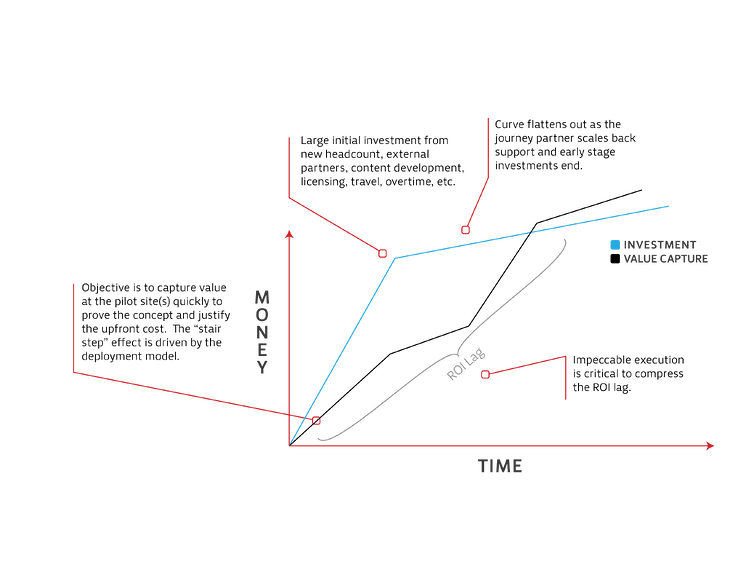This blog post is part one of a three-part series.
Last week I had the privilege of speaking to a group of Continuous Improvement and Operations Leaders at the Generis American Manufacturing Summit in Chicago. The topic was “How to Ensure ROI from Your Continuous Improvement Approach,” which is one that I’ve written about previously but had not delivered to a live audience until last week.
EON's goal any time that we interject our experience and insights into the larger discussion of all things continuous improvement related is to sincerely attempt to provide a unique perspective or otherwise get folks thinking about these issues differently. One way that we did that at last week’s conference was to share our view on how to manage the investment in a broad-based deployment without sacrificing on deployment pace or quality of outcomes. The next three blog posts (including this one) are dedicated to articulating that view by looking at two “traditional” CI deployment models and then comparing them to a third model that we believe offers the best of all worlds so to speak.
Option 1: The Brute Force Model
The Brute Force Model is characterized by a substantial early stage investment in CI in preparation for a “shotgun” based deployment of the continuous improvement model to multiple locations in a relatively short period of time. The early stage investment falls into a number of different categories, including:
- Incremental headcount in the form of corporate, regional, and/or site-level CI resources
- Use of an external journey partner (i.e., a consulting firm) to design the CI model and help deploy it
- Licensing of instructional content and/or building your own content
- Travel costs
- Employee overtime
Companies that undertake this model are generally hoping to generate significant internal momentum for CI and drive up the performance curve quickly through a focused and intensive effort to surface to biggest performance improvement opportunities and surgically go after a select set of them right away. When done well, this model can generate quick returns and provide line of sight into future opportunities. However, there are significant risks and challenges with this model, all of which we’ve seen first-hand (on multiple occasions we’ve worked with clients after they’ve undertaken the brute force deployment model due to the risks/challenges shown below):
- ROI-lag – what we mean is that the upfront investment in this model is often so significant that, even if your execution if impeccable, you will need to prepare for the reality that it will be quite a while before the value derived catches up to those investments. And that can be a tough business case to make, particularly to business leaders who have some skepticism about the value of CI.
- Location-level disruption – many organizations underestimate the amount of disruption that the brute force model can create for locations where it is being implemented. What can happen with this model is that a “SWAT team” of internal CI experts and external consultants make their way to the site for 8-12 consecutive weeks, commandeer critical site-level leaders and experts so that they cannot perform their core job responsibilities, hijack the site leadership team’s calendars, all the while not clearly communicating what they’re doing and why. The result is that the process frustrates many of the very people that it should be engaging, so instead of a process that creates engagement, you end up with one that creates resistance.
- Sustainability risk – partly because the deployment process does not drive engagement as described above and partly due to the fact that the locations are not provided with the right tools to manage the improvement journey on their own following the deployment (an Excel spreadsheet with a list of improvement projects is not sufficient), the likelihood that the sites will regress to their previous performance levels within 12-24 months of a brute force deployment is significant
The chart below is designed to visually represent the Brute Force Model. Long story made short, while there is certainly an appeal associated with making a strong initial commitment to CI and driving an approach specifically designed to get some initial results and create line of sight to future opportunity, this model also carries significant risk and may not set the organization up for success over the long-term. In the next post, we’ll take a closer look at the benefits and drawbacks of an Incremental Deployment model.
 EON
EON
At EON, we’ve partnered with leading companies to drive a structured and disciplined approach to their CI journey to ensure business impact and sustainability. The experience gained over a period of years is what led us to develop EON. EON helps companies that are committed to a systemic approach to continuous improvement to set and manage strategy, execute improvement projects, implement best practices, and calculate their operational gap to perfect. Our leading indicators scorecard provides unparalleled business intelligence in the form of activity- and outcome-based metrics to help our clients to better manage their continuous improvement implementations.
Please contact us to learn more about EON, the world’s first comprehensive continuous improvement management platform.

